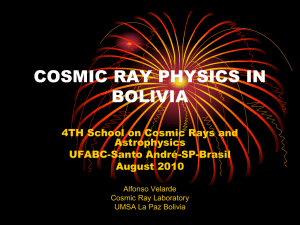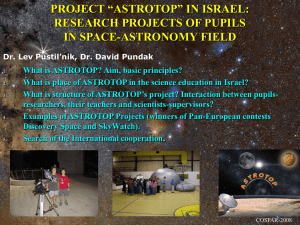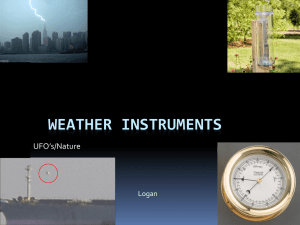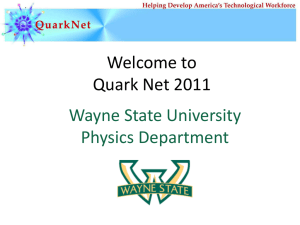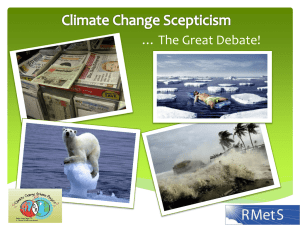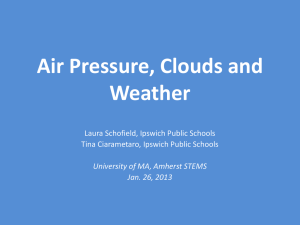PowerPoint - Climate Conferences
advertisement
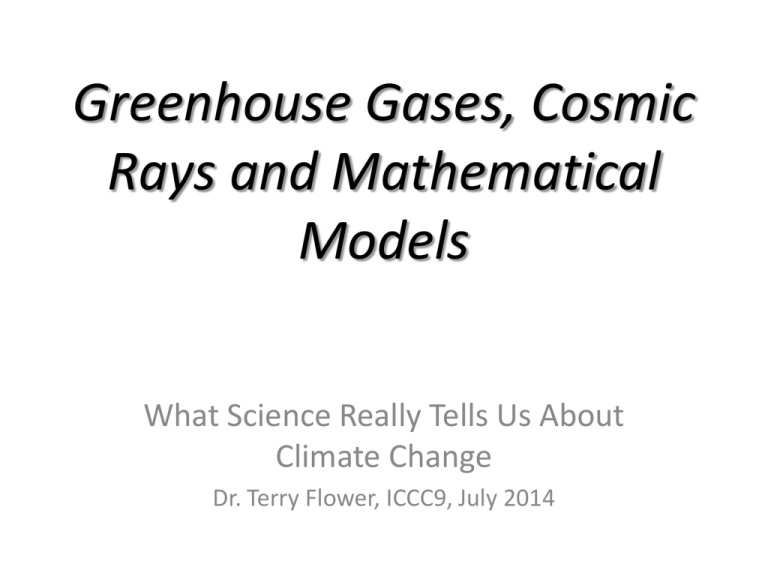
Greenhouse Gases, Cosmic Rays and Mathematical Models What Science Really Tells Us About Climate Change Dr. Terry Flower, ICCC9, July 2014 What I will tell you • What Science is capable of telling us What I will tell you • What Science is capable of telling us • Greenhouse Gases What I will tell you • What Science is capable of telling us • Greenhouse Gases • Cosmic Rays and the Sun What I will tell you • • • • What Science is capable of telling us Greenhouse Gases Cosmic Rays and the Sun Mathematical Modeling What I will tell you • • • • • What Science is capable of telling us Greenhouse Gases Cosmic Rays and the Sun Mathematical Modeling What I predict will be the future trend Science has been successful • We got to the moon Science has been successful • We got to the moon • We’ve made medical advances Science has been successful • We got to the moon • We’ve made medical advances • Look at computers Science has been successful • • • • We got to the moon We’ve made medical advances Look at computers The digital age Science has been successful • • • • • We got to the moon We’ve made medical advances Look at computers The digital age Hubble Space Telescope Science has been successful • • • • • • We got to the moon We’ve made medical advances Look at computers The digital age Hubble Space Telescope Missions to the Solar System Science vs. Pseudo-Science TV Commercials make connections between science and their product Department Names at Universities • • • • • Mathematical Science Family, Consumer and Nutrition Science Exercise Science Social Science Political Science The Structure of Scientific Revolutions Thomas Kuhn, 1962 • How Science is done • Scientists perform experiments to reenforce the existing “Paradigm” • Existing “Paradigm” leads to crisis • New “Paradigm” • Vast differences between political and scientific revolutions but both have a common metaphor Parallelism in Science and Politics • Both cease to meet needs of (at least) a segment of both communities that they themselves created • The sense of malfunction leads to crisis • Choice of a paradigm cannot be settled by logic and experiment alone – it depends on what works rather than truth itself Water Vapor - the Main Greenhouse Gas • Eric Fetzer, an atmospheric scientist who works with AIRS data at NASA's Jet Propulsion Laboratory in Pasadena, Calif. "Water vapor is the big player in the atmosphere as far as climate is concerned.“ • If we don’t understand water vapor contributions we don’t understand the climate. Clouds are not well understood Clouds • • • • Cover 65% of the Earth, on the average Can have a net cooling effect of 30 W/m2 Anthropogenic sources are 1.6 W/m2 total Need to include cooling effect of clouds Solar Activity and Climate Connection Inactive sun (low sunspot peak, long cycle length) > cold climate Active sun (high sunspot peak, short cycle length) > warm climate Solar magnetic field deflects galactic cosmic rays. • Lower B field → increased GCR → increased monsoon intensity • Henrik Svensmark – The Chilling Stars an explanation of the physical mechanism, not yet confirmed Cloud – GCR Effects • Original GCR-cloud correlation made by Svensmark & Friis-Christensen, 1997 • Many studies since then supporting or disputing solar/GCR - cloud correlation • Not independent - most use the same ISCCP satellite cloud dataset • No firm conclusion yet - requires more data - but, if there is an effect, it is likely to be restricted to certain regions of globe and at certain altitudes & conditions • •Eg. correlation (>90% sig.) of low cloud amount and solar UV/GCR,1984-2004: • Aerosol chamber + state-of-the-art analyzing instruments in CERN PS beamline • Laboratory expts. under precisely controlled conditions (T, trace gases, aerosols, ions) • Study aerosol nucleation & growth; and cloud droplet & ice particle microphysics Orbiting Carbon Observatory Launched July 2 Satellites in “A-Train” • Orbiting Carbon Observatory-2 (OCO-2), which launched July 2, will be the A-Train's sixth member. Its mission is to measure atmospheric carbon dioxide • Information on aerosols and clouds from CALIPSO and CloudSat, we can use that information to estimate the amount of absorption of sunlight by these airborne particles, which is something we cannot currently do, • MODIS (Moderate Resolution Imaging Spectroradiometer), an instrument on the Aqua satellite, tracks cloud cover. AIRS (Atmospheric Infrared Sounder), another Aqua instrument, measures air temperature and the amount of water content in the atmosphere. To accurately measure carbon dioxide Poincare’ (1854-1912) • New Methods of Celestial Mechanics, 1892 Poincare’ (1854-1912) • New Methods of Celestial Mechanics, 1892 • Nonlinear dynamical equations are subject to Poincare’ (1854-1912) • New Methods of Celestial Mechanics, 1892 • Nonlinear dynamical equations are subject to • Sensitivity to initial conditions Poincare’ (1854-1912) • • • • New Methods of Celestial Mechanics, 1892 Nonlinear dynamical equations are subject to Sensitivity to initial conditions Unpredictably chaotic outcomes Ocean Levels Summary and Forecast • Climate has continually varied in the past, and the causes are not well understood - especially on the 100 year timescale relevant for today’s climate change Summary and Forecast • Climate has continually varied in the past, and the causes are not well understood - especially on the 100 year timescale relevant for today’s climate change • Space satellites will show water vapor’s dominant role as a greenhouse gas Summary and Forecast • Climate has continually varied in the past, and the causes are not well understood - especially on the 100 year timescale relevant for today’s climate change • Space satellites will show water vapor’s dominant role as a greenhouse gas • Strong evidence for solar-climate variability, but no established mechanism. A cosmic ray influence on clouds is a leading candidate. Research will confirm this mechanism in a controlled laboratory experiment; satellites can help our understanding Summary and Forecast • Climate has continually varied in the past, and the causes are not well understood - especially on the 100 year timescale relevant for today’s climate change • Space satellites will show water vapor’s dominant role as a greenhouse gas • Strong evidence for solar-climate variability, but no established mechanism. A cosmic ray influence on clouds is a leading candidate. Research will confirm this mechanism in a controlled laboratory experiment; satellites can help our understanding • The question of whether - and to what extent - the climate is influenced by solar/cosmic ray variability remains central to our understanding of anthropogenic climate change Summary and Forecast • Climate has continually varied in the past, and the causes are not well understood - especially on the 100 year timescale relevant for today’s climate change • Space satellites will show water vapor’s dominant role as a greenhouse gas • Strong evidence for solar-climate variability, but no established mechanism. A cosmic ray influence on clouds is a leading candidate. Research will confirm this mechanism in a controlled laboratory experiment; satellites can help our understanding • The question of whether - and to what extent - the climate is influenced by solar/cosmic ray variability remains central to our understanding of anthropogenic climate change • Crisis of conformity; Political Correctness will continue to be problematic




